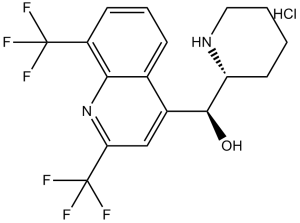This product is for research use only, not for human use. We do not sell to patients.

| Size | Price | Stock |
|---|---|---|
| 2g | $250 | Check With Us |
| 10g | $750 | Check With Us |
| 20g | $1125 | Check With Us |
Cat #: V1908 CAS #: 51773-92-3 Purity ≥ 98%
Description: Mefloquine HCl (Mefloquin) is a blood schizonticide which inhibits hemozoin formation, and is used as a phospholipid-interacting antimalarial drug. Mefloquine is widely used in both the treatment and prophylaxis of Plasmodium falciparum malaria. Mefloquine can induces oxidative stress in vitro. Evidence indicates that reactive oxygen species (ROS) may be used as a therapeutic modality to kill cancer cell. Mefloquine inhibited KvLQT1/minK channel currents with an IC50 value of approximately 1 μM. Mefloquine slowed the activation rate of KvLQT1/minK and more block was evident at lower membrane potentials compared with higher ones.
Publications Citing InvivoChem Products
Product Promise

- Physicochemical and Storage Information
- Protocol
- Related Biological Data
- Stock Solution Preparation
- Quality Control Documentation
| Molecular Weight (MW) | 414.77 |
|---|---|
| Molecular Formula | C17H17ClF6N2O |
| CAS No. | 51773-92-3 |
| Storage | -20℃ for 3 years in powder formr |
| -80℃ for 2 years in solvent | |
| Solubility In Vitro | DMSO: 82 mg/mL (197.7 mM)r |
| Water: <1 mg/mLr | |
| Ethanol: 82 mg/mL (197.7 mM) | |
| SMILES Code | C1CCNC(C1)C(C2=CC(=NC3=C2C=CC=C3C(F)(F)F)C(F)(F)F)O.Cl |
| Synonyms | WR-177,602; WR142,490; WR177,602; Ro215998001; Ro-215998001; Ro 215998001; Mefloquine Hydrochloride; Mephaquin; Mefloquine HCl; Loriam; |
| Protocol | In Vitro | In vitro activity: Mefloquine is a quinoline antimalarial drug that is structurally related to the antiarrhythmic agent quinidine. Mefloquine is widely used in both the treatment and prophylaxis of Plasmodium falciparum malaria. MQ can induces oxidative stress in vitro. Evidence indicates that reactive oxygen species (ROS) may be used as a therapeutic modality to kill cancer cells. Cell Assay: Mefloquine inhibitedKvLQT1/minK channel currents with an IC50 value of approximately 1 microM. Mefloquine slowed the activation rate of KvLQT1/minK and more block was evident at lower membrane potentials compared with higher ones. HERG channel currents were about 6-fold less sensitive to block by mefloquine (IC50 = 5.6 microM). Block of HERG displayed a positive voltage dependence with maximal inhibition obtained at more depolarized potentials. MQ has a highly selective cytotoxicity that inhibits PCa cell growth. MQ-mediated ROS simultaneously downregulated Akt phosphorylation and activated extracellular signal-regulated kinase (ERK), c-Jun N-terminal kinase (JNK) and adenosine monophosphate-activated protein kinase (AMPK) signaling in PC3 cells. |
|---|---|---|
| In Vivo | Pregnant rats were treated orally with AS (15 and 40 mg/kg body weight (bwt)/day), MQ (30 and 80 mg/kg bwt/day) and AS/MQ (15/30 and 40/80 mg/kg bwt/day) on days 9-11 post coitum (pc). The dams were euthanized on day 12 pc and gestational and embryos histological parameters were evaluated. | |
| Animal model | Rats | |
| Dosages | 30 and 80 mg/kg; oral gavage |
| Solvent volume to be added | Mass (the weight of a compound) | |||
|---|---|---|---|---|
| Mother liquor concentration | 1mg | 5mg | 10mg | 20mg |
| 1mM | 2.4110 mL | 12.0549 mL | 24.1097 mL | 48.2195 mL |
| 5mM | 0.4822 mL | 2.4110 mL | 4.8219 mL | 9.6439 mL |
| 10mM | 0.2411 mL | 1.2055 mL | 2.4110 mL | 4.8219 mL |
| 20mM | 0.1205 mL | 0.6027 mL | 1.2055 mL | 2.4110 mL |
This equation is commonly abbreviated as: C1 V1 = C2 V2
- (1) Please be sure that the solution is clear before the addition of next solvent. Dissolution methods like vortex, ultrasound or warming and heat may be used to aid dissolving.
- (2) Be sure to add the solvent(s) in order.




































